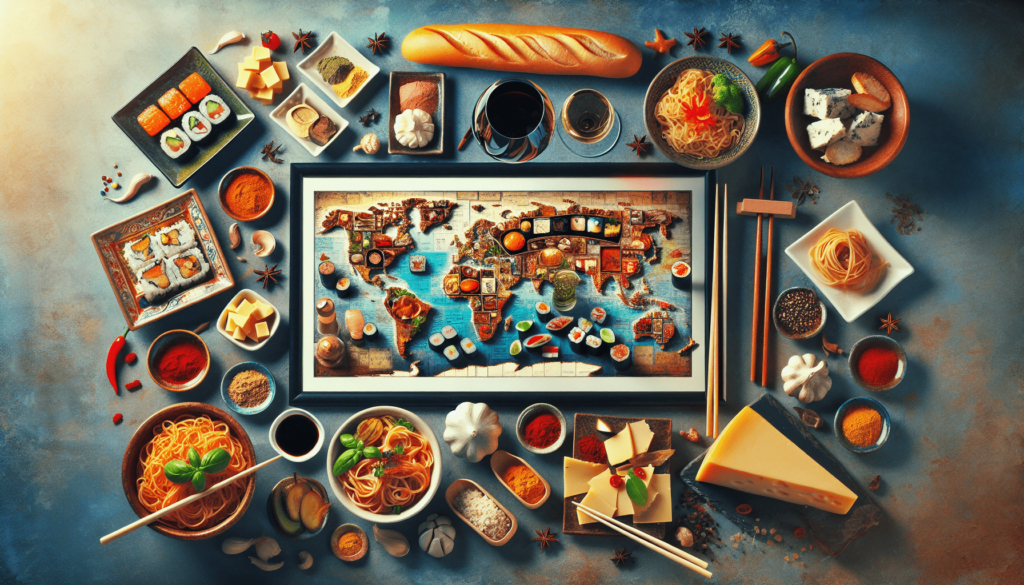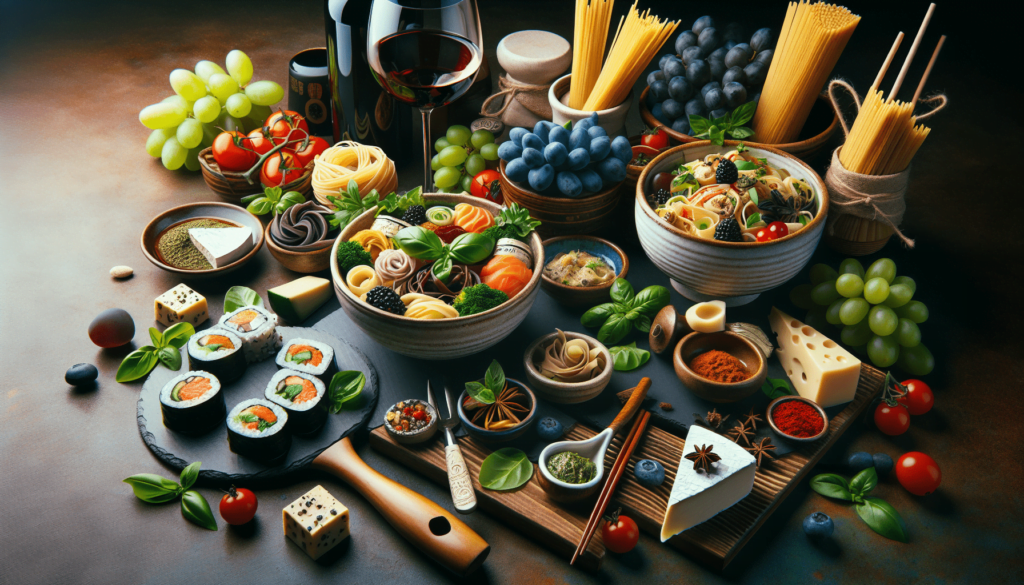Embark on a flavorful journey with “The Culinary Adventures of a Food Lover,” a delightful exploration of global cuisine through the eyes of someone truly passionate about food. This captivating article provides a rich historical context of culinary traditions while exploring current trends shaping the food industry. You’ll dive into detailed examinations of different cooking styles, ingredients, and food cultures, reflecting on their evolution and current-day relevance. With engaging case studies and comparisons of various culinary perspectives, the text thoroughly analyzes the influences and implications of these diverse traditions.
Packed with insightful predictions and highlighting the future directions of the food scene, this article serves as both a guide and an inspiration for any food enthusiast, offering a comprehensive and delectable look at the world of gastronomy. Join this culinary odyssey and broaden your palate, discovering the profound stories behind your favorite dishes. The Culinary Adventures of a Food Lover
Have you ever wondered what it would be like to embark on a journey solely for the delight of your taste buds? Imagine traveling from the bustling streets of Bangkok to the aromatic kitchens of Bologna, savoring the rich tapestry of flavors, ingredients, and culinary traditions the world has to offer.
The appeal of culinary exploration lies not just in the food itself, but in the stories, people, and cultures behind every dish. From learning age-old techniques to discovering innovative culinary creations, the adventure is endless for a food lover.

Table of Contents
Historical Context of Culinary Exploration
The love for food and the desire to explore different culinary traditions is not a modern phenomenon. Historically, food has always been a major driving force behind exploration and travel. Ancient trade routes, such as the Silk Road and Spice Route, were established primarily for the exchange of edible treasures like spices, herbs, and unique ingredients. These routes not only facilitated commerce but also cultivated a global exchange of culinary knowledge and traditions.
Take Marco Polo’s legendary journey to China, for instance. Alongside trading goods, he also brought back fascinating stories and new culinary techniques that have since influenced Western cuisine. Similarly, the Age of Exploration saw European explorers like Columbus, Magellan, and Vasco da Gama bring back new ingredients such as tomatoes, potatoes, and chocolate, forever changing the course of global cuisine.
Current Trends in Culinary Adventures
Today, the culinary world is more interconnected than ever, thanks to globalization and the internet. Food lovers no longer have to rely on arduous journeys to experience exotic cuisines. Television shows, food blogs, and social media platforms have made it easier to explore and immerse yourself in global culinary traditions from the comfort of your home.
Moreover, trends such as farm-to-table, fusion cuisine, and molecular gastronomy have broadened the horizon for culinary adventures. Chefs are not just cooking; they are innovating, experimenting, and often turning dining into a multi-sensory experience. Pop-up restaurants, food festivals, and cooking classes are continuously emerging, giving food lovers endless opportunities to dive deeper into the culinary world.
What is Farm-to-Table?
The farm-to-table movement focuses on sourcing ingredients directly from local farms, aiming to reduce the time food spends in transit. This approach ensures fresher ingredients and contributes to sustainable agriculture. It emphasizes the importance of seasonal produce, encouraging chefs and home cooks alike to create dishes that celebrate what’s naturally available during different times of the year.
Fusion Cuisine Explained
Fusion cuisine is the art of blending culinary traditions from different cultures. For instance, Korean tacos or sushi burritos are perfect examples of culinary fusion, combining elements from diverse culinary backgrounds to create something entirely unique and delightful.
Detailed Exploration of Culinary Subtopics
Street Food: The Ultimate Gastronomic Adventure
Street food offers a unique window into the heart of a culture. In many parts of the world, street vendors are often the unsung heroes of the culinary scene, providing flavorful, accessible, and authentic food to locals and tourists alike. Let’s take a closer look at two prime examples of street food excellence:
Bangkok, Thailand: A Street Food Paradise
Imagine wandering through the overcrowded streets of Bangkok, where the fragrant aroma of grilled meats, fresh herbs, and exotic spices envelops you. Street vendors sell beloved local dishes such as Pad Thai, Som Tum (green papaya salad), and Mango Sticky Rice. The bustling environment adds to the charm, making every bite not just a gastronomic delight but also a memorable experience.
Mexico City, Mexico: Tacos to Die For
Now, picture yourself in Mexico City, where the scent of sizzling meat and freshly made tortillas draws you into a nearby food stall. Street vendors here serve mouth-watering tacos filled with succulent meats, bright salsas, and vibrant toppings. You experience the true essence of Mexican cuisine, made right before your eyes with ingredients sourced from local markets.
Borough Markets: Local Culinary Treasures
Markets have always been central to communities worldwide, offering not just fresh produce, but also a glimpse into the everyday lives of people. They are treasure troves of culinary diversity where local farmers, artisans, and chefs come together.
La Boqueria, Barcelona
La Boqueria is a veritable feast for the senses. Situated in the heart of Barcelona, this market offers an array of products from fresh seafood to cured meats, cheeses, and local wines. The vibrant stalls, enthusiastic vendors, and lively atmosphere epitomize Spain’s rich culinary culture.
Borough Market, London
Borough Market showcases the quintessential British love for quality and variety. Here, you can find everything from artisanal bread and organic vegetables to exotic spices and gourmet street food. The market’s blend of traditional and contemporary offerings makes it a must-visit for any food lover.
Impact of Culinary Traditions on Modern Cuisine
Culinary traditions have a profound impact on modern cuisine, sparking inspiration and innovation among chefs worldwide. In this section, we’ll delve into examples that highlight the significance of these age-old practices.
The Renaissance of Italian Cuisine: Bologna and Beyond
Italian cuisine is celebrated for its simplicity, fresh ingredients, and robust flavors. But what makes it truly special is its deep connection to tradition. In Bologna—the gastronomical capital of Italy—you can find dishes like Tagliatelle al Ragù and Tortellini that have been perfected over generations.
Chefs today often draw inspiration from these time-honored recipes, even as they introduce modern twists. The balance of adhering to tradition while innovating has made Italian cuisine a perennial favorite.
The Platter of Indian Spices
Indian cuisine, with its diverse use of spices, offers a sensory explosion unmatched by any other cuisine. From the rich Butter Chicken of Punjab to the savory Dosas of South India, each dish carries a unique blend of spices that tell a story.
Modern chefs are increasingly interested in understanding and incorporating these complex spice blends into their menus, bringing traditional Indian flavors to a global audience. This exploration extends beyond taste—it’s about understanding the cultural significance and history associated with these spices.

Fusion vs. Authenticity: Different Perspectives
The blending of culinary traditions and the preservation of authentic flavors represent two different but equally valid approaches in contemporary cuisine. Both have their merits and cater to varying tastes and expectations.
The Case for Fusion Cuisine
Fusion cuisine allows for creativity and innovation. By blending culinary methods and ingredients from different cultures, chefs can create novel dishes that offer a unique dining experience. This approach often attracts food lovers looking for something unexpected and exciting.
The Importance of Authenticity
On the other hand, authenticity is crucial for preserving culinary heritage. Authentic dishes offer a genuine taste of a region’s culinary history and culture. For many food lovers, experiencing traditional dishes in their original form provides a deeper connection to a place and its people.
Balancing the Two
Balancing fusion and authenticity can be a challenging but rewarding endeavor. Some chefs manage to strike a perfect harmony, introducing new elements to traditional dishes without losing their essence. This approach brings the best of both worlds to the table, making culinary adventures more enriching.
Future Directions and Implications
Predictions for the Culinary World
The culinary world is ever-evolving, with trends coming and going. However, some aspects appear to be here to stay:
-
Sustainability: With growing awareness of environmental issues, there will likely be a stronger focus on sustainable practices in food sourcing and preparation.
-
Health-conscious Dining: As people become more health-conscious, there will be a greater emphasis on nutritious ingredients and balanced meals.
-
Culinary Tourism: With barriers for travel reducing globally, culinary tourism is predicted to see significant growth. Food lovers will increasingly travel to explore diverse culinary landscapes.
Implications for Society
The exploration of global cuisines fosters cultural understanding and appreciation. Food is a universal language that can bridge cultural gaps and bring people closer together. Culinary adventures encourage individuals to embrace diversity, fostering a more inclusive and harmonious world.
Conclusion
Recap
Throughout this culinary journey, we’ve explored the rich historical context of food exploration, current trends shaping the culinary world, and the impact of traditional practices on modern cuisine. We’ve delved into the vibrant world of street food, the treasure troves of local markets, and the ongoing debate between fusion and authenticity.
Final Thought
So, the next time you sit down to a meal, take a moment to appreciate the journey each ingredient has taken to reach your plate. Consider the hands that cultivated it, the traditions that shaped it, and the stories it tells. Are you ready for your own culinary adventure?
Engagement
We’d love to hear about your culinary adventures! Have you discovered any hidden gems or memorable food experiences on your travels? Share your stories in the comments below, and don’t forget to explore our recommended resources for further reading.
Credible Sources
- Anderson, Eugene N. “The Food of China.” Yale University Press, 1988.
- Symons, Michael. “A History of Cooks and Cooking.” University of Illinois Press, 2000.
- Ray, Krishnendu. “The Migrant’s Table: Meals and Memories in Bengali-American Households.” Temple University Press, 2004.
- Pollan, Michael. “The Omnivore’s Dilemma: A Natural History of Four Meals.” Penguin Press, 2006.
- Feniger, Susan, and Mary Sue Milliken. “Street Food: Exploring the Worlds’s Most Authentic Tastes.” Clarkson Potter, 2012.
Saif Food Lover: A Delightful Journey of Culinary Adventures
